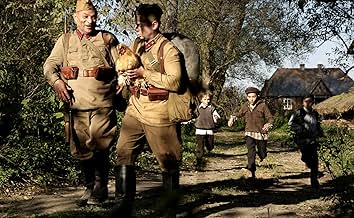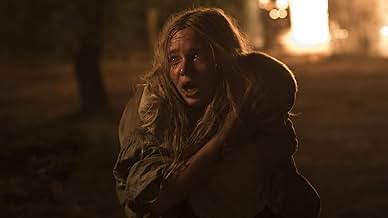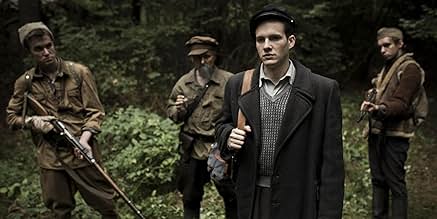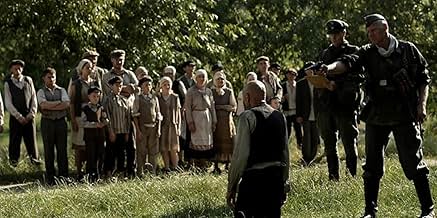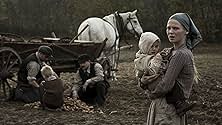IMDb RATING
7.6/10
7.3K
YOUR RATING
Despite being in love with a Ukrainian boy from the same village, Polish girl named Zosia is forced into marrying a wealthy widower. Soon World War II begins and ethnic tensions arise. Amids... Read allDespite being in love with a Ukrainian boy from the same village, Polish girl named Zosia is forced into marrying a wealthy widower. Soon World War II begins and ethnic tensions arise. Amidst the war chaos Zosia tries to survive.Despite being in love with a Ukrainian boy from the same village, Polish girl named Zosia is forced into marrying a wealthy widower. Soon World War II begins and ethnic tensions arise. Amidst the war chaos Zosia tries to survive.
- Director
- Writer
- Stars
- Awards
- 17 wins & 7 nominations total
- Director
- Writer
- All cast & crew
- Production, box office & more at IMDbPro
Featured reviews
I must say that I'm shocked by this movie. Massacre usually happens during invasion, for example Japan did several massacres to China including the Nanjing Massacre (which Japan still doesn't admit). But this one happened in Wolyn is even worse, because it happened between neighborhoods, they were living together, harvesting together, marrying to each other, then someday UPA came, everything changed. I saw the very worst of human nature inspired by the nationalism. All good thing slaughtered.
A very powerful movie. The acting and cinematography were excellent. Michalina Labacz especially shines in her lead role. Although the movie is two and a half hours long the pacing keeps your attention throughout.
As many have noted, this film has a great deal of graphic violence. Not only quick killings, but also gruesome torture. It is a testament to the director that for the most part he does not linger on such scenes. For me, it was not always the case, and there were several times that I had to look away.
The characters are numerous and of many nationalities and religions, but the movie rarely casts anyone as black and white caricatures. No side comes out as pure and innocent, or completely evil. Along with the massacres by Ukrainians, we also see the arrogance of Polish upper class village residents, and even protection by some German soldiers.
The swirl of death on all sides and by all sides leaves one numb by the end, but it important story. In addition to telling the story of an often overlooked part of East European history, it also is a more general warning of how easily the dark side of humanity can come forward in times of adversity.
As many have noted, this film has a great deal of graphic violence. Not only quick killings, but also gruesome torture. It is a testament to the director that for the most part he does not linger on such scenes. For me, it was not always the case, and there were several times that I had to look away.
The characters are numerous and of many nationalities and religions, but the movie rarely casts anyone as black and white caricatures. No side comes out as pure and innocent, or completely evil. Along with the massacres by Ukrainians, we also see the arrogance of Polish upper class village residents, and even protection by some German soldiers.
The swirl of death on all sides and by all sides leaves one numb by the end, but it important story. In addition to telling the story of an often overlooked part of East European history, it also is a more general warning of how easily the dark side of humanity can come forward in times of adversity.
10ktrelski
When I went to see this movie I thought I know everything about the events this picture is based on. I have heard that the movie will show them without any censorship. However, I was not prepared for the real horror of those events. The movie is graphic, but it does not go overboard. It does, however touch your soul. If you ever asked yourself what the real terror looks like, this is it. What makes it tough is that the terror is brought to you by the people you know well, your next door neighbors, your spouse or even your brother.
Do not expect anybody laughing or even talking after the movie is over.
It is a great movie. Don't miss it.
Do not expect anybody laughing or even talking after the movie is over.
It is a great movie. Don't miss it.
...but not really known in the rest of Europe and world. Important film, nobody every told this story in the film world. Very graphic though - as usual with the director Smarzowski. Most of his films are made with this idea of starting with light themes, here it's a wedding and then with time becoming more and more dark and gloomy. This one will leave you speechless. I strongly recommend this one, but viewer discretion is strongly advised.
The eastern limits of Poland were set after WWI along the Curzon line, roughly today's boundary. After Poland's victory over the Bolsheviks in the Russian Civil War, the boundary was shifted East. Some regions of the former Austro-Hungarian Empire such as Volhyn (the original title of this movie) and Eastern Galicia became de facto Polish, although Poles were a minority; for Volhyn the percentages were 70%, 16% and 10% for Ukrainians, Poles and Jews.
The film begins with a village wedding in Volyn shortly before the outbreak of WWII. The various ethnic groups are seen living in wary mistrust of each other. From conversations we learn that Ukrainians resent their heavy handed treatment by Polish authorities. Use of the Ukrainian language is forbidden or discouraged. Ukrainian schools are being closed. So are Orthodox and Greek Catholic churches, some demolished, others converted to Catholic churches.
In September 1939 the Soviets occupy Volhyn and Eastern Galicia in answer to Hitler's invasion of Poland. In June 1941 the region is overrun and occupied by Nazi troops on their way to invade the Soviet Union. Initially, some Ukrainians welcome the Germans in the belief they would support a free, independent Ukraine, but this hope is soon dashed. Some extreme right wing diehards such as the OUN = Organization of Ukrainian Nationalists and its paramilitary branch the UPA = Ukrainian Insurgent Army ally themselves with the occupiers and carry out a bloody campaign of ethnic cleansing against Polish and other minorities. This is the backdrop for the story, which centers on the the vicissitudes of bride Hela and sister Zosia during the war.
This film does everything well, including an even handed treatment of controversial history. It is spoken in Polish, Ukrainian and Russian and the subtitles do a good job of identifying each language. It is available in the streaming services under the title Hatred, the name of the novel on which it is based.
The film begins with a village wedding in Volyn shortly before the outbreak of WWII. The various ethnic groups are seen living in wary mistrust of each other. From conversations we learn that Ukrainians resent their heavy handed treatment by Polish authorities. Use of the Ukrainian language is forbidden or discouraged. Ukrainian schools are being closed. So are Orthodox and Greek Catholic churches, some demolished, others converted to Catholic churches.
In September 1939 the Soviets occupy Volhyn and Eastern Galicia in answer to Hitler's invasion of Poland. In June 1941 the region is overrun and occupied by Nazi troops on their way to invade the Soviet Union. Initially, some Ukrainians welcome the Germans in the belief they would support a free, independent Ukraine, but this hope is soon dashed. Some extreme right wing diehards such as the OUN = Organization of Ukrainian Nationalists and its paramilitary branch the UPA = Ukrainian Insurgent Army ally themselves with the occupiers and carry out a bloody campaign of ethnic cleansing against Polish and other minorities. This is the backdrop for the story, which centers on the the vicissitudes of bride Hela and sister Zosia during the war.
This film does everything well, including an even handed treatment of controversial history. It is spoken in Polish, Ukrainian and Russian and the subtitles do a good job of identifying each language. It is available in the streaming services under the title Hatred, the name of the novel on which it is based.
Did you know
- TriviaBefore ending credits: "In the period of 1943-45, an estimated 80 to 10 thousand Poles and 10 to 15 thousand Ukrainians had fallen victim to Ukrainian nationalists' attacks and Polish retaliations in the Eastern borderlands."
- How long is Hatred?Powered by Alexa
Details
- Release date
- Country of origin
- Official site
- Languages
- Also known as
- Wolyn
- Filming locations
- Production companies
- See more company credits at IMDbPro
Box office
- Budget
- PLN 10,000,000 (estimated)
- Gross worldwide
- $6,960,645
Contribute to this page
Suggest an edit or add missing content

